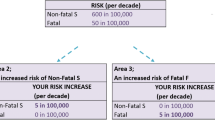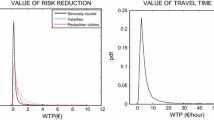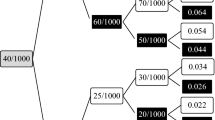Abstract
This article reports the results of a study designed to elicit willingness to pay (WTP) and willingness to accept (WTA) values for changes in the risk of nonfatal road injuries. We examine the possibility that individuals' preferences over combinations of wealth, risk, and safety are imprecise, and that this imprecision might result in the observed disparity between WTP and WTA measures of value. The results confirm that individuals' preferences for safety are significantly imprecise, but that this alone is insufficient to explain more than part of the disparity. Indeed, respondents' estimates of the minimum that they would be prepared to accept for a risk increase frequently exceed the maximum that they would be prepared to pay for an equivalent risk reduction.
Similar content being viewed by others
References
Brookshire, D.S., and D.L. Coursey. (1987). “Measuring the Value of a Public Good: An Empirical Comparison of Elicitation Procedures,”American Economic Review 77, 554–66.
Coursey, D.L., J.L. Hovis, and W.D. Schulze. (1987). “The Disparity Between Willingness to Accept and Willingness to Pay Measures of Value,”Quarterly Journal of Economics 102, 679–90.
Cummings, R.G., D.S. Brookshire, and W.D. Schulze (eds.). (1986).Valuing Environmental Goods: An Assessment of the Contingent Valuation Method. Totowa, NJ: Rowan & Allenhald.
Dalvi, M.Q. (1988).The Value of Life and Safety: A Search for a Consensus Estimate. London: Department of Transport.
Dubourg, W.R., M.W. Jones-Lee, and G. Loomes. (1993). “The Contingent Valuation of Transport Safety: Imprecise Preferences and the Disparity Between Willingness-to-Pay and Willingness-to-Accept,” CSERGE Discussion Paper GEC93.16, Centre for Social and Economic Research on the Global Environment, University College London and University of East Anglia.
Fischer, G.W., et al. (1986). “Risk Preferences for Gains and Losses in Multiple Objective Decision Making,”Management Science 32, 1065–1086.
Fischhoff, B. (1991). “Eliciting Values: Is There Anything In There?” In L. Cooper and M. Hechter (eds.),Values. Stanford: Stanford University Press.
Fischhoff, B., and L. Furby. (1988). “Measuring Values: A Conceptual Framework for Interpreting Transactions with Special Reference to Contingent Valuation of Visibility,”Journal of Risk and Uncertainty 1, 147–84.
Hanemann, W.M. (1991). “Willingness to Pay and Willingness to Accept: How Much Can They Differ?”American Economic Review 81, 635–47
Jones-Lee, M.W., M. Hammerton, and P.R. Philips. (1985). “The Value of Safety: Results of a National Sample Survey,”Economic Journal 95, 49–72
Jones-Lee, M.W., et al. (1993). “The Value of Preventing Non-Fatal Road Injuries: Findings of a Willingness-to-Pay National Sample Survey,” Transport and Road Research Laboratory Working Paper WPSRC2, Transport and Road Research Laboratory, Bracknell.
Kahneman, D., and A. Tversky. (1979). “Prospect Theory: An Analysis of Decision-making Under Risk,”Econometrica 47, 263–291.
Kahneman, D., J.L. Knetsch, and R.H. Thaler. (1990). “Experimental Tests of the Endowment Effect and the Coase Theorem,”Journal of Political Economy 98, 1325–48.
Knetsch, J.L. (1990). “Environmental Policy Implications of Disparities Between Willingness to Pay and Compensation Demanded Measures of Values,”Journal of Environmental Economics and Management 18, 227–37
Knetsch, J.L., and J.A. Sinden. (1984). “Willingness to Pay and Compensation Demanded: Experimental Evidence of an Unexpected Disparity in Measures of Value,”Quarterly Journal of Economics 99, 507–21.
McDaniels, T.L. (1992). “Reference Points, Loss Aversion, and Contingent Values for Auto Safety,”Journal of Risk and Uncertainty 5, 187–200.
Payne, J.W., J.R. Bettman, and E.J. Johnson. (1992). “Behavioral Decision Research: A Constructive Processing Perspective,”Annual Review of Psychology 43, 87–131.
Pearce, D.W., and I. Knight. (1989). “Valuation of Non-Fatal Road Accident Casualties: An Evaluation of Alternative Approaches,” Department of Economics Discussion Paper, University College London.
Road Accidents Great Britain 1989: The Casualty Report. London: HMSO.
Samuelson, W., and R. Zeckhauser. (1988). “Status Quo Bias in Decision Making,”Journal of Risk and Uncertainty 1, 7–59.
Thaler, R.H. (1980). “Toward a Positive Theory of Consumer Choice,”Journal of Economic Behavior and Organization 1, 39–60.
Thaler, R.H. (1985). “Mental Accounting and Consumer Choice,”Marketing Science 4, 199–214.
Tversky, A., and D. Kahneman. (1991). “Loss Aversion in Riskless Choice: A Reference Dependent Model,”Quarterly Journal of Economics 107, 1039–61.
Viscusi, W.K., W.A. Magat, and J. Huber. (1987). “An Investigation of the Rationality of Consumer Valuations of Multiple Health Risks,”RAND Journal of Economics 18, 465–479.
Author information
Authors and Affiliations
Rights and permissions
About this article
Cite this article
Dubourg, W.R., Jones-Lee, M.W. & Loomes, G. Imprecise preferences and the WTP-WTA disparity. J Risk Uncertainty 9, 115–133 (1994). https://doi.org/10.1007/BF01064181
Issue Date:
DOI: https://doi.org/10.1007/BF01064181




